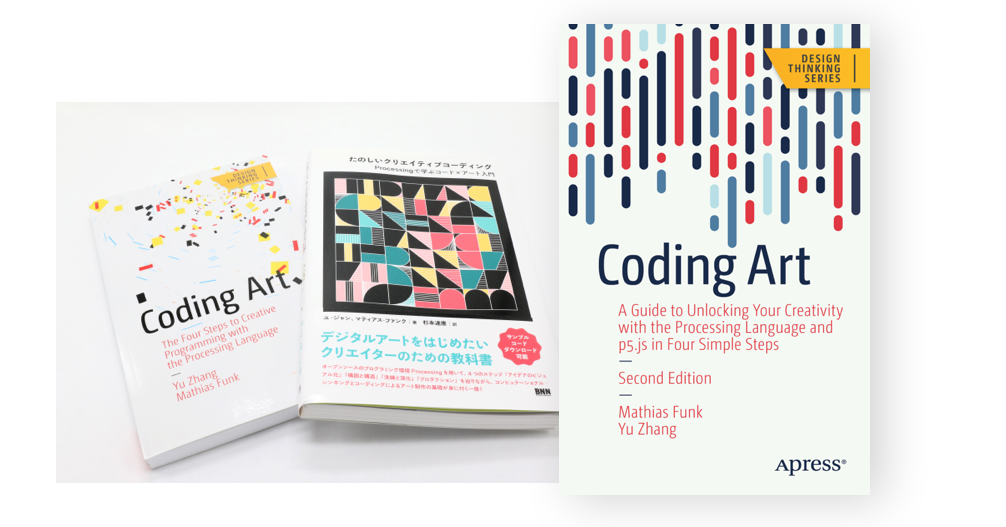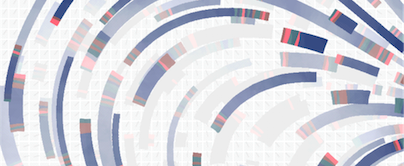

by Mathias Funk and Yu Zhang, December 2023.
Finally, a book on creative programming, written directly for artists and designers! This second edition offers expanded and updated content incorporating the latest advancements and trends in the field of creative programming, also for creatives who want to work directly with P5.js and online. It delves deeper into the intricacies of computational art. It includes fresh case studies that explore real-world applications of coding art, inspiring readers to think beyond traditional boundaries.
Rather than following a computer science curriculum, this book is aimed at creatives who are working in the intersection of design, art, and education. All code examples are presented in a fully integrated Processing example library, making it easy for readers to get started.
This unique and finely balanced approach between skill acquisition and development makes Coding Art, Second Edition the ideal reference book for both creative programming and the creative process for professors and students alike.
Available from:
apress
·
Amazon
·
Barnes & Noble
·
Bookshop
·
Bol.com
The first edition of "Coding Art" was published in January 2021. See below for more information.
Available from: apress · Amazon · Barnes & Noble · Bookshop · Bol.com
Paperback: 280 pages, Language: EnglishThe Japanese edition of "Coding Art" was published in June 2023 by BNN.
ISBN:978-4-8025-1275-6Coding Art is based on the Processing language and p5.js. The book integrates "art thinking" and "computational thinking" in practice, by using a 4-step process that unfolds over 74 code examples and one larger artwork case. The primary motivation for this book is to teach a new creative process intertwined with creative computation. We want to inspire artists and designers to work with computation effortlessly and confidently. The book focuses on practical examples and includes both high-quality renderings and code of all examples. All examples are also available in a Processing example library.
In this book, we write about creative (computational) techniques that we taught to hundreds of students over the years. We deliver what worked for them and what we believe will also work for the readers. You'll follow a real-world use case of computation art and see how it relates back to the four key pillars, and addresses potential pitfalls and challenges in the creative process. All code examples are presented in a fully integrated Processing example library, making it easy for readers to get started.
This unique and finely balanced approach between skill acquisition and the creative process and development makes Coding Art a functional reference book for both creative programming and the creative process for professors and students alike.
In the second edition, we have incorporated lots of feedback for text and code examples. But foremost, we have added two entirely new chapters on p5.js: starting with a few inspirations on generative art, we show you how to make use of the four steps and create a series of static and interactive pieces. And we do this with p5.js, so all pieces are ready for the web.
In chapter 8, we take on a whole new challenge: creating experiences on mobile devices with acceleration and device orientation. Again we use p5.js and go through several steps. This is how you make generative art interactive.


Mathias Funk is Associate Professor in the Department of Industrial Design at the Eindhoven University of Technology (TU/e). He has a background in Computer Science and a PhD in Electrical Engineering. His research interests include complex systems design, remote data collection, design for musical expression, and design tools. In his teaching he focuses on designing with technology and data. He is regularly invited to give international workshops on large-scale interactive systems, group music improvisation interfaces and expressive (musical) interaction. He has been an active musician for years, and is very interested in the intersection of music, art, and design in particular.
An artist by training, Yu Zhang finished her PhD in 2017 on the theory and artistic practice of interactive technologies for public, large-scale installations. She approaches visual art with mixed reality installations and projections, sensor-based interactives, and computational arts. She roots her artistic intent in the symbolism of Asian traditions and transforms the artistic unpacking of drama and cultural signifiers into experiences of interactivity and connectivity that ultimately bridge artistic expression and audience experience. Yu's teaching experiences cover over ten years and a board space including traditional classrooms and design-led project-based learning activities.


Those looking to see what computation and data can do for their creative expression; learners who want to integrate computation and data into their practices in different perspectives; and those who already know how to program, seeking creativity and inspiration in the context of computation and data.
Coding Art as a creative programming book based on the Processing platform is also for higher-education professionals in university and art school programs. The book offers various ideas for educators to set up related lectures in a flexible way. It can be readily used as teaching resource as all code examples are available from a companion example library integrated in Processing.
The book is for you, the creatives working in the fields of design, art, or architecture-- and for anyone interested in using computer programming and interactive technologies as expressive tools in their professional practice. Coding Art book is practically meaningful as a process reference for creatives’ practices. With the Coding Art book, we structure the content in a creative process with four progressive steps, helping you express ideas into both visual and computing structures.
Newsletter
Sign up and we will notify you once there are news about Coding Art.